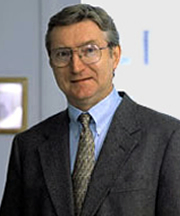
A paper published by a team of University of Notre Dame researchers in the January 13 edition of the journal Science reveals the demonstration of logic in a magnetic system, thereby opening the door to all-magnetic information processing systems.
Wolfgang Porod, Freimann Professor of Electrical Engineering and director of Notre Dames Center for Nano Science and Technology, is co-inventor, with Craig S. Lent, also a Freimann Professor of Electrical Engineering, of Quantum-Dot Cellular Automata (QCA), a transistorless approach to computing.
Conventional microelectronic technology has relied on shrinking transistors to produce increasingly smaller, faster and more powerful computers. However, because the laws of physics prevent conventional devices from working below a certain size, that method is nearing its physical limits.
QCA leapfrogs that barrier with an entity known as aquantum dot,a tiny structure in which an electron can be confined. These quantum dots can be created and arranged into cells through microelectronic techniques, and in turn, these cells can be lined up end to end to formbinary wiresor arrayed to form switches and various computer logic devices.
If successful, a future one-centimeter square molecular QCA chip could contain as many as 1 trillion devices, as opposed to the 6 million devices in the most advanced conventional chip. And since it does not rely on flowing electrons to transmit a signal, no electric current is produced and heat problems are avoided.
However, as Porod and other Notre Dame researchers have attempted to implement the QCA concept, they have encountered certain problems in its applications. Stray charges from the quantum dots presented difficulties and current technological limitations in fabrication meant that QCA operating temperatures had to be extremely low, thereby reducing its practical applications.
As an alternative, Porod and Notre Dame researchers Alexandra Imre, Lili Ji, Alexei Orlov and Gary Bernstein, in conjunction with Gyorgy Csaba of the Institute for Nanoelectronics at the Technical University of Munich, decided to study magnetic systems for QCA implementations.
The basic idea is the same as for the original electronic QCA, except that nanomagnets hold the information and magnetic interactions are used to perform logic,Porod said.We were quite surprised to learn how strong magnetic interactions are between nanomagnets, which can be fabricated quite easily.
Magnets are already being used in memory and data storage, but the Notre Dame teams research demonstrates that nanomagnets can be used for logic functions.
In our opinion, the main significance is the demonstration of logic in a magnetic system, which opens the door to all-magnetic information processing systems, including memory and logic,Porod said.
The magnetic QCA approach also helps solve many of the problems that exist with the original electronic QCA.
Advantages of magnetic QCA include room-temperature operation, and this technology also leverages advances made by the magnetic-storage industry for patterned magnetic media,Porod said.
One of the advantages of QCA is that it requires only low power to operate and a potential application of the magnetic version includes portable systems where power is at a premium. The technology may also lead to an all-magnetic information processing system, including memory and logic, which uses little or no electricity.
In the future, we would like to fabricate larger structures, beyond the single majority logic gate demonstrated so far,Porod said.Also, we would like to realize electronic ways to set the input and to read the output. So far, inputs are set by external magnetic fields.
* Contact: * _Wolfgang Porod, Freimann Professor of Electrical Engineering, 574-631-6376, porod@nd.edu _
TopicID: 15182